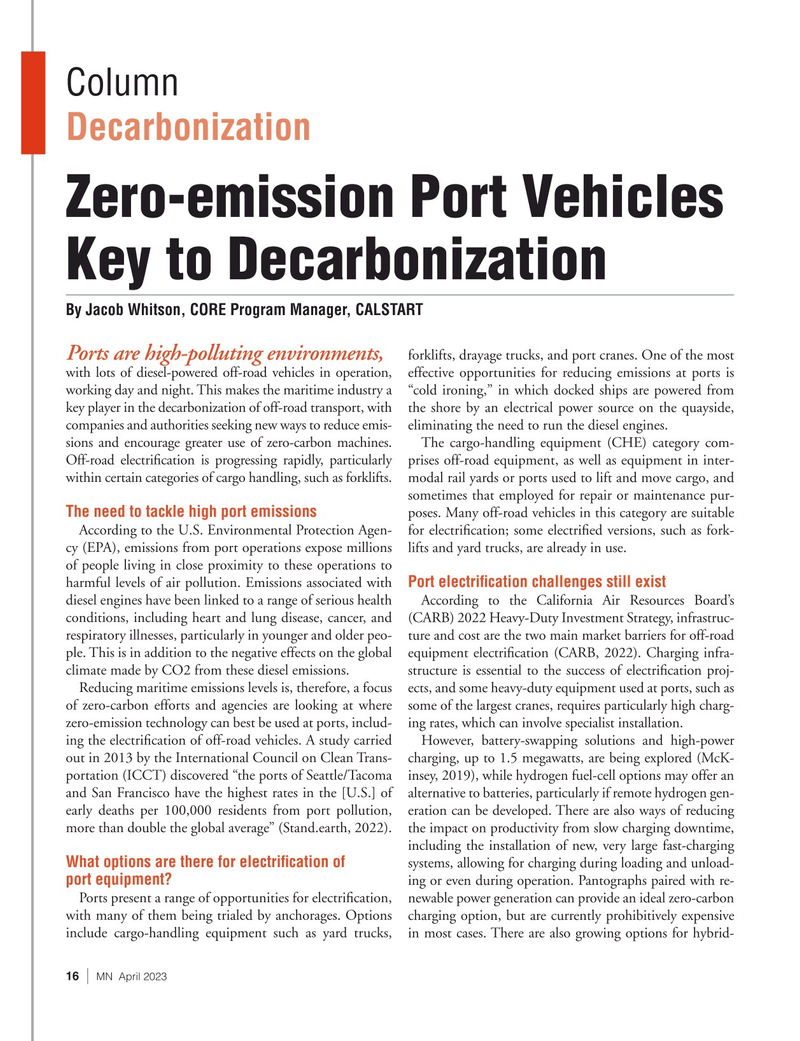
Page 16: of Marine News Magazine (April 2023)
Towboats, Tugs & Barges
Read this page in Pdf, Flash or Html5 edition of April 2023 Marine News Magazine
Column
Decarbonization
Zero-emission Port Vehicles
Key to Decarbonization
By Jacob Whitson, CORE Program Manager, CALSTART forklifts, drayage trucks, and port cranes. One of the most
Ports are high-polluting environments, with lots of diesel-powered off-road vehicles in operation, effective opportunities for reducing emissions at ports is working day and night. This makes the maritime industry a “cold ironing,” in which docked ships are powered from key player in the decarbonization of off-road transport, with the shore by an electrical power source on the quayside, companies and authorities seeking new ways to reduce emis- eliminating the need to run the diesel engines.
sions and encourage greater use of zero-carbon machines. The cargo-handling equipment (CHE) category com-
Off-road electri? cation is progressing rapidly, particularly prises off-road equipment, as well as equipment in inter- within certain categories of cargo handling, such as forklifts. modal rail yards or ports used to lift and move cargo, and sometimes that employed for repair or maintenance pur-
The need to tackle high port emissions poses. Many off-road vehicles in this category are suitable
According to the U.S. Environmental Protection Agen- for electri? cation; some electri? ed versions, such as fork- cy (EPA), emissions from port operations expose millions lifts and yard trucks, are already in use.
of people living in close proximity to these operations to harmful levels of air pollution. Emissions associated with
Port electri? cation challenges still exist diesel engines have been linked to a range of serious health According to the California Air Resources Board’s conditions, including heart and lung disease, cancer, and (CARB) 2022 Heavy-Duty Investment Strategy, infrastruc- respiratory illnesses, particularly in younger and older peo- ture and cost are the two main market barriers for off-road ple. This is in addition to the negative effects on the global equipment electri? cation (CARB, 2022). Charging infra- climate made by CO2 from these diesel emissions. structure is essential to the success of electri? cation proj-
Reducing maritime emissions levels is, therefore, a focus ects, and some heavy-duty equipment used at ports, such as of zero-carbon efforts and agencies are looking at where some of the largest cranes, requires particularly high charg- zero-emission technology can best be used at ports, includ- ing rates, which can involve specialist installation.
ing the electri? cation of off-road vehicles. A study carried However, battery-swapping solutions and high-power out in 2013 by the International Council on Clean Trans- charging, up to 1.5 megawatts, are being explored (McK- portation (ICCT) discovered “the ports of Seattle/Tacoma insey, 2019), while hydrogen fuel-cell options may offer an and San Francisco have the highest rates in the [U.S.] of alternative to batteries, particularly if remote hydrogen gen- early deaths per 100,000 residents from port pollution, eration can be developed. There are also ways of reducing more than double the global average” (Stand.earth, 2022). the impact on productivity from slow charging downtime, including the installation of new, very large fast-charging
What options are there for electri? cation of systems, allowing for charging during loading and unload- port equipment?
ing or even during operation. Pantographs paired with re-
Ports present a range of opportunities for electri? cation, newable power generation can provide an ideal zero-carbon with many of them being trialed by anchorages. Options charging option, but are currently prohibitively expensive include cargo-handling equipment such as yard trucks, in most cases. There are also growing options for hybrid- 16 | MN April 2023

 15
15

 17
17
